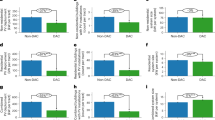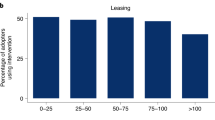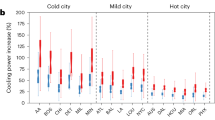Abstract
The rooftop solar industry in the United States has experienced dramatic growth—roughly 50% per year since 2012, along with steadily falling prices. Although the opportunities this affords for clean, reliable power are transformative, the benefits might not accrue to all individuals and communities. Combining the location of existing and potential sites for rooftop photovoltaics (PV) from Google’s Project Sunroof and demographic information from the American Community Survey, the relative adoption of rooftop PV is compared across census tracts grouped by racial and ethnic majority. Black- and Hispanic-majority census tracts show on average significantly less rooftop PV installed. This disparity is often attributed to racial and ethnic differences in household income and home ownership. In this study, significant racial disparity remains even after we account for these differences. For the same median household income, black- and Hispanic-majority census tracts have installed less rooftop PV compared with no majority tracts by 69 and 30%, respectively, while white-majority census tracts have installed 21% more. When correcting for home ownership, black- and Hispanic-majority census tracts have installed less rooftop PV compared with no majority tracts by 61 and 45%, respectively, while white-majority census tracts have installed 37% more. The social dispersion effect is also considered. This Analysis reveals the racial and ethnic injustice in rooftop solar participation.
This is a preview of subscription content, access via your institution
Access options
Access Nature and 54 other Nature Portfolio journals
Get Nature+, our best-value online-access subscription
$29.99 / 30 days
cancel any time
Subscribe to this journal
Receive 12 digital issues and online access to articles
$119.00 per year
only $9.92 per issue
Buy this article
- Purchase on Springer Link
- Instant access to full article PDF
Prices may be subject to local taxes which are calculated during checkout





Similar content being viewed by others
Data availability
The data that support the findings of this study are available from Google Project Sunroof (https://www.google.com/get/sunroof/data-explorer/) and the 2009–2013 5-year ACS27. The computer codes used for this study are available online at https://github.com/DeborahSunter/Rooftop-PV-Deployment-Disparities.
References
Fu, R., Feldman, D., Margolis, R., Woodhouse, M. & Ardani, K. US Solar Photovoltaic System Cost Benchmark: Q1 2017 Technical Report (National Renewable Energy Laboratory, 2017).
Haegel, N. M. et al. Terawatt-scale photovoltaics: trajectories and challenges. Science 356, 141–143 (2017).
Solar Market Insight Report 2017 Q3 Technical Report (Solar Energy Industries Association, 2017).
Feldman, D. & Bolinger, M. On the Path to SunShot: Emerging Opportunities and Challenges in Financing Solar (National Renewable Energy Laboratory, 2016).
Richter, L.-L. Social Effects in the Diffusion of Solar Photovoltaic Technology in the UK Working Paper (Univ. Cambridge, 2013).
Bollinger, B. & Gillingham, K. Peer effects in the diffusion of solar photovoltaic panels. Market. Sci. 31, 900–912 (2012).
Graziano, M. & Gillingham, K. Spatial patterns of solar photovoltaic system adoption: the influence of neighbors and the built environment. J. Econ. Geogr. 15, 815–839 (2015).
Pyper, J. New US residential solar capacity down 17% year-over-year for Q1. Green Tech Media https://www.greentechmedia.com/articles/read/residential-solar-capacity-down-17-year-over-year-for-q1#gs.a=WhwhI (2017).
Rai, V., Reeves, D. C. & Margolis, R. Overcoming barriers and uncertainties in the adoption of residential solar PV. Renew. Energy 89, 498–505 (2016).
Ghaith, A. F., Epplin, F. M. & Scott Frazier, R. Economics of grid-tied household solar panel systems versus grid-only electricity. Renew. Sust. Energy Rev. 76, 407–424 (2017).
Kann, S. & Toth, A. How Wealthy are Residential Solar Customers? Household Income and SolarAdoption in the US (GTM Research, 2017).
Renew300 Federal Renewable Energy Target (US Department of Housing and Urban Development, 2016).
Report on Alternative Approaches to Providing Low and Moderate Income (LMI) Clean Energy Services Technical report (Clean Energy Advisory Council and LMI Clean Energy Initiatives Working Group, 2017).
California Public Utilities Commission. CPUC creates $100 million solar for multifamily affordable housing program. EE Online https://electricenergyonline.com/article/energy/category/solar/142/673274/cpuc-creates-100-million-solar-for-multifamily-affordable-housing-program.html (2017).
Dodson, G., Hutchison, E. & Omoletski, J. New Solar Homes Partnership Guidebook 11th edn CEC-300-2017-054-ED11CMF (California Energy Commission, 2017).
Baker, C. D., Polito, K. E., Beaton, M. A. & Judson, J. Solar Massachusetts Renewable Target (SMART) Final Program Design Technical Report (Massachusetts Department of Energy Resources, 2017).
Low- and Moderate-Income Solar Policy Basics (National Renewable Energy Laboratory, 2017).
Cowell, R. Wind power, landscape and strategic, spatial planning—the construction of ‘acceptable locations’ in Wales. Land Use Policy 27, 222–232 (2010).
Gross, C. Community perspectives of wind energy in Australia: the application of a justice and community fairness framework to increase social acceptance. Energy Policy 35, 2727–2736 (2007).
Jenkins, K., McCauley, D., Heffron, R., Stephan, H. & Rehner, R. Energy justice: a conceptual review. Energy Res. Soc. Sci. 11, 174–182 (2016).
Sovacool, B. K., Heffron, R. J., McCauley, D. & Goldthau, A. Energy decisions reframed as justice and ethical concerns. Nat. Energy 1, 16024 (2016).
Yenneti, K. & Day, R. Procedural (in)justice in the implementation of solar energy: the case of Charanaka solar park, Gujarat, India. Energy Policy 86, 664–673 (2015).
Simpson, G. & Clifton, J. Subsidies for residential solar photovoltaic energy systems in Western Australia: distributional, procedural and outcome justice. Renew. Sust. Energy Rev. 65, 262–273 (2016).
Catney, P. et al. Big society, little justice? Community renewable energy and the politics of localism. Local Environ. 19, 715–730 (2014).
Sengupta, M. et al. The National Solar Radiation Data Base (NSRDB). Renew. Sust. Energy Rev. 89, 51–60 (2018).
Electric Power Monthly with Data for May 2018 Technical Report (US Energy Information Administration, July 2018); https://www.eia.gov/electricity/monthly/
2015 Planning Database (US Census Bureau, 2015); https://www.census.gov/research/data/planning_database/2015/
Glasmeier, A. K. Living wage calculator (Massachusetts Institute of Technology, 2018); http://livingwage.mit.edu/
Cilluffo, A., Geiger, A. & Fry, R. More US households are renting than at any point in 50 years. Pew Research Center http://www.pewresearch.org/fact-tank/2017/07/19/more-u-s-households-are-renting-than-at-any-point-in-50-years/ (2017).
Inskeep, B., Daniel, K. & Proudlove, A. Solar on Multi-unit Buildings: Policy and Financing Options to Address Split Incentives Technical Report (Solar Outreach Partnership, 2015).
Colgate, S. A., Stanley, E. A., Hyman, J. M., Layne, S. P. & Qualls, C. Risk behavior-based model of the cubic growth of acquired immunodeficiency syndrome in the United States. Proc. Natl Acad. Sci. USA 86, 4793–4797 (1989).
Taylor, D. E. Green jobs and the potential to diversify the environmental workforce. Utah Environ. Law Rev. 31, 47–77 (2011).
US Solar Industry Diversity Study: Current Trends, Best Practices, and Recommendations Technical Report (The Solar Foundation, 2017).
Taylor, D. E. Blacks and the environment: toward an explanation of the concern and action gap between blacks and whites. Environ. Behav. 21, 175–205 (1989).
CA SB-338 Integrated Resource Plan: Peak Demand (LegiScan, 2017); https://legiscan.com/CA/bill/SB338/2017
Project Sunroof Data Explorer: a Description of Methodology and Inputs Technical Report (Google Project Sunroof, 2017).
Folch, D. C., Arribas-Bel, D., Koschinsky, J. & Spielman, S. E. Spatial variation in the quality of American Community Survey estimates. Demography 53, 1535–1554 (2016).
Poverty Thresholds (US Census Bureau, 2013); https://www.census.gov/data/tables/time-series/demo/income-poverty/historical-poverty-thresholds.html
Gagnon, P., Margolis, R., Melius, J., Phillips, C. & Elmore, R. Rooftop Solar Photovoltaic Technical Potential in the United States: a Detailed Assessment Technical Report (National Renewable Energy Laboratory, 2016).
Seabold, S. & Perktold, J. Statsmodels: economic and statistical modeling with Python. In Proc. 9th Python Sci. Conf. 57–61 (2010).
Efron, B. & Tibshirani, R. Bootstrap methods for standard errors, confidence intervals, and other measures of statistical accuracy. Stat. Sci. 1, 54–75 (1986).
Acknowledgements
The authors thank Google’s Project Sunroof team for providing valuable data, and S. Hsiang for insightful discussions. D.A.S. gratefully acknowledges support from the Energy Efficiency and Renewable Energy Postdoctoral Research Award from the US Department of Energy and Berkeley Institute for Data Science. S.C. gratefully acknowledges support from the Berkeley Energy and Climate Institute–Instituto Tecnológico de Estudios Superiores de Monterrey Energy Fellowship. D.M.K. acknowledges support from the Karsten Family Foundation and Zaffaroni Family Foundation.
Author information
Authors and Affiliations
Contributions
D.A.S. and S.C. designed and performed the research, analysed the data and wrote the paper. D.M.K. supervised the research, guided the study and edited the paper.
Corresponding authors
Ethics declarations
Competing interests
The authors declare no competing interests.
Additional information
Publisher’s note: Springer Nature remains neutral with regard to jurisdictional claims in published maps and institutional affiliations.
Supplementary information
Supplementary Information
Supplementary Figures 1–5, Supplementary Tables 1–3.
Rights and permissions
About this article
Cite this article
Sunter, D.A., Castellanos, S. & Kammen, D.M. Disparities in rooftop photovoltaics deployment in the United States by race and ethnicity. Nat Sustain 2, 71–76 (2019). https://doi.org/10.1038/s41893-018-0204-z
Received:
Accepted:
Published:
Issue Date:
DOI: https://doi.org/10.1038/s41893-018-0204-z
This article is cited by
-
Equitable rooftop photovoltaics deployment
Nature Energy (2024)
-
Exploring the potential of non-residential solar to tackle energy injustice
Nature Energy (2024)
-
It starts at home: non-economic factors influencing consumer acceptance of battery storage in Australia
Environmental Science and Pollution Research (2024)
-
Reply to: Revised estimates of racial and ethnic disparities in rooftop photovoltaic deployment in the United States
Nature Sustainability (2023)
-
Revised estimates of racial and ethnic disparities in rooftop photovoltaic deployment in the United States
Nature Sustainability (2023)



